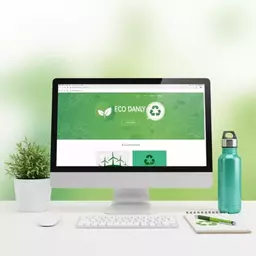What if your website could not only engage users but also help save the planet? Embracing sustainable web design is not just beneficial for the environment; it's a smart business move that can enhance user experience and drive down costs. Dive into the key learnings from the importance of eco-friendly practices in web design.
What You Will Learn
- Sustainable web design significantly reduces the carbon footprint while cutting down operational costs.
- Implementing green principles leads to energy-efficient coding and eco-friendly hosting solutions.
- Websites designed with longevity in mind avoid frequent overhauls, translating to savings.
- User experience improves with fast-loading sites and clear navigation, increasing retention rates.
- Sustainable practices can enhance SEO efforts, leading to better rankings and reduced bounce rates.
- Digital accessibility is integral to sustainable web design, ensuring inclusivity for all users.
Key Pillars and Benefits of Sustainable Web Design
Sustainable web design focuses on three key areas to achieve both environmental responsibility and business advantages. These practices lead to several interconnected benefits for user experience, SEO, and cost-effectiveness. For a deeper dive into improving your website's performance, consider exploring a comprehensive guide to optimizing your website's performance.
Understanding Sustainable Web Design and Its Cost Benefits
As a web design professional, I can tell you that sustainable web design is not just a trend—it's a necessity! Building websites that prioritize sustainability can significantly reduce our carbon footprint while also yielding notable cost benefits for businesses. In today’s digital landscape, where energy consumption is a growing concern, embracing sustainable practices is both responsible and practical.
When we think about sustainable websites, it's essential to realize that they are designed with longevity and energy efficiency in mind. This means we not only create aesthetically pleasing sites but also ones that operate efficiently and minimize environmental impact. By understanding these principles, we can make informed choices that benefit both our clients and the planet!

The Importance of Building Sustainable Websites
Building sustainable websites starts with recognizing the profound impact our digital presence has on the environment. Every line of code, every image, and every hosting choice contributes to energy use. That's why it's crucial to implement green principles in our design process. Sustainable web design is about creating a balance between aesthetics and functionality while ensuring we leave a positive footprint. To learn more about design principles, consider reading about the power of visual hierarchy in web design.
- Reduce energy consumption through efficient coding practices.
- Utilize eco-friendly hosting solutions that use renewable energy.
- Focus on long-lasting design elements to avoid frequent overhauls.
When we adopt these practices, we not only enhance our brand image as being environmentally conscious but also align with a growing market demand for sustainability. It's a win-win situation for everyone involved!
How Cost-Effective Strategies Align with Green Principles
Many people might think that going green is synonymous with high costs, but that’s a common misconception. In fact, embracing sustainable web design can lead to significant savings in both operational and maintenance costs. By utilizing efficient coding and optimizing resources, businesses can maintain a competitive edge while reducing their overall expenditure.
- Minimizing server costs by reducing bandwidth through optimized designs.
- Decreasing energy bills with energy-efficient hosting solutions.
- Lowering the frequency of redesigns through sustainable practices.
By implementing these cost-effective strategies, we can create websites that not only meet current needs but also anticipate future challenges, making them a smart investment for any business.
Evaluating the Impact of Low-Carbon Footprint Designs
As we venture deeper into sustainable web design, it's essential to evaluate the impact of our choices. Low-carbon footprint designs are characterized by their minimal energy consumption throughout their lifecycle—from creation to hosting. This evaluation not only helps in understanding how we contribute to a greener planet but also reinforces our commitment to sustainability.
- Assessing the energy efficiency of hosting providers and their practices.
- Monitoring website performance metrics to ensure optimal resource use.
- Gathering feedback on user experience to continuously improve design sustainability.
By keeping track of these factors, we can make informed adjustments that further minimize our environmental impact while enhancing our clients' web presence. It’s all about creating a lasting change, both online and in the real world.
We Want to Hear From You!
What aspect of sustainable web design excites you the most? Is it the potential cost savings, the environmental impact, or the enhanced user experience? Share your thoughts below:
Enhancing User Experience through Sustainable Practices
When we think about web design, one crucial aspect often gets overlooked: the user experience! Sustainable practices not only make our websites environmentally friendly but can significantly enhance user engagement and satisfaction. By integrating sustainable design elements, we're not just being kind to the planet; we're also creating a better experience for our visitors.
Imagine a site that loads quickly, is easy to navigate, and has a minimal carbon footprint. This combination can lead to higher user retention rates and improved conversion rates. By focusing on sustainability, we're setting ourselves up for long-term success. For those interested in improving their website's speed, learn how to optimize website speed for a lightning-fast experience.

Impact of Sustainable Design on User Retention and Conversion
Incorporating sustainable design features can positively influence how users interact with your website. Here are some ways sustainable practices can boost retention and conversion:
- Improved Performance: Fast-loading sites keep users engaged longer.
- Clear Navigation: User-friendly interfaces reduce frustration and encourage exploration.
- Trust and Credibility: Users are more likely to support brands that prioritize sustainability.
When users feel good about their choices, they're more inclined to return. This creates a solid foundation for building long-lasting customer relationships.
SEO Benefits Tied to Eco-Friendly Web Design
Did you know that sustainable web design can also enhance your SEO efforts? Search engines like Google favor sites that load quickly and provide a great user experience. Here’s how green practices can improve your SEO:
- Faster Load Times: Optimized sites rank higher in search results.
- Reduced Bounce Rates: Engaging, sustainable design keeps users on your site longer.
- Better Content Delivery: Utilizing CDNs ensures your content reaches users efficiently.
By embracing eco-friendly design, you not only align with sustainable principles but also enhance your online visibility!
The Role of Digital Accessibility in Sustainable Web Design
Digital accessibility is a vital component of sustainable web design. It ensures that everyone, regardless of their abilities, can access and enjoy your website. Here are some key aspects to consider:
- Responsive Design: Make sure your site works well on all devices.
- Alt Text for Images: Use descriptive text for images to aid visually impaired users.
- Keyboard Navigation: Ensure your site can be navigated using a keyboard for those who cannot use a mouse.
Incorporating accessibility into your design not only broadens your audience but also reflects your commitment to inclusivity and sustainability. At Web Designer Near Me Digest, we believe that everyone deserves a seamless online experience!
Resources and Tools for Implementing Sustainable Strategies
Ready to take your commitment to sustainable web design up a notch? There are many resources and tools available to help you implement these strategies effectively.
Essential Tools for Image Optimization and Code Minification
Using the right tools can make a significant difference in your website's performance. Here’s a list of essential tools to consider:
- ImageOptim: Great for compressing images without losing quality.
- UglifyJS: A popular tool for minifying JavaScript files.
- CSSNano: Perfect for optimizing your CSS files.
Leveraging these tools can help you maintain a lean website that enhances user experience while being environmentally conscious.
Directory of Green Hosting Providers and Certifications
Choosing the right hosting provider is crucial for sustainable web practices. Here are a few eco-friendly hosting providers to consider:
- GreenGeeks: Known for its commitment to sustainability and renewable energy.
- SiteGround: Offers energy-efficient hosting solutions.
- WP Engine: Provides options that support green practices.
Check for certifications that indicate a commitment to sustainability when selecting your hosting partner!
Recommended Content Management Systems (CMS) for Sustainability
Not all content management systems are created equal when it comes to sustainability. Here are some recommended options that prioritize eco-friendly practices:
- WordPress: Highly customizable and can be optimized for sustainability.
- Joomla: Offers flexibility in design while supporting green initiatives.
- Ghost: A lightweight platform that focuses on speed and efficiency.
Selecting the right CMS can streamline your sustainable web design efforts and ensure a smoother experience for your users.
Frequently Asked Questions About Sustainable Web Design
- What is sustainable web design?
- Sustainable web design is the practice of creating websites that minimize environmental impact, reduce energy consumption, and are built for longevity, while also providing a positive user experience and cost-effectiveness.
- How does sustainable web design benefit businesses?
- It benefits businesses by reducing operational costs (e.g., server and energy bills), enhancing user experience through faster load times and better navigation, improving SEO rankings, and boosting brand credibility by showcasing environmental responsibility.
- What are some core principles of sustainable web design?
- Core principles include efficient coding practices, utilizing eco-friendly hosting solutions that use renewable energy, and designing websites with longevity in mind to avoid frequent overhauls.
- Can sustainable web design improve SEO?
- Yes, sustainable web design can significantly improve SEO. Faster load times (a result of optimized code and assets) are favored by search engines, leading to higher rankings. Reduced bounce rates and better user engagement also contribute positively to SEO.
- Why is digital accessibility important for sustainable web design?
- Digital accessibility ensures that websites are usable by everyone, regardless of their abilities, promoting inclusivity. This broadens the audience and reflects a commitment to responsible and ethical design, which aligns with the broader goals of sustainability.
Concluding Thoughts on Cost-Effective Sustainable Web Design
As we move towards a more eco-conscious world, embracing sustainable web design is not just a trend—it's a necessity! At Web Designer Near Me Digest, we encourage everyone to adopt these practices, not only for the benefit of our planet but also for the enhancement of user experience.
Encouraging Adoption of Sustainable Practices for Future Growth
By integrating sustainable strategies, you’re not just improving your online presence; you’re paving the way for future growth in a responsible manner. It’s a win-win situation!
Call to Action: Start Your Sustainable Website Journey Today
Ready to make a difference? Let’s embark on this journey together! Head over to Web Designer Near Me Digest for more insights and practical tips on sustainable web design. Together, we can create a brighter, greener future!
Recap of Key Points
Here is a quick recap of the important points discussed in the article:
- Sustainable web design reduces carbon footprints while also offering cost benefits.
- Implement green principles such as efficient coding and eco-friendly hosting to enhance both performance and sustainability.
- Embrace cost-effective strategies like minimizing server costs and lowering redesign frequencies to save resources.
- Low-carbon footprint designs require ongoing evaluation of energy efficiency and user experience metrics.
- Sustainable practices can enhance user experience, retention, and conversion rates.
- Search engines favor quick-loading, engaging sites, making sustainable design beneficial for SEO.
- Digital accessibility is crucial; ensure your website is usable for all, enhancing inclusivity.
- Utilize tools for image optimization and choose eco-friendly hosting providers to support sustainability initiatives.









